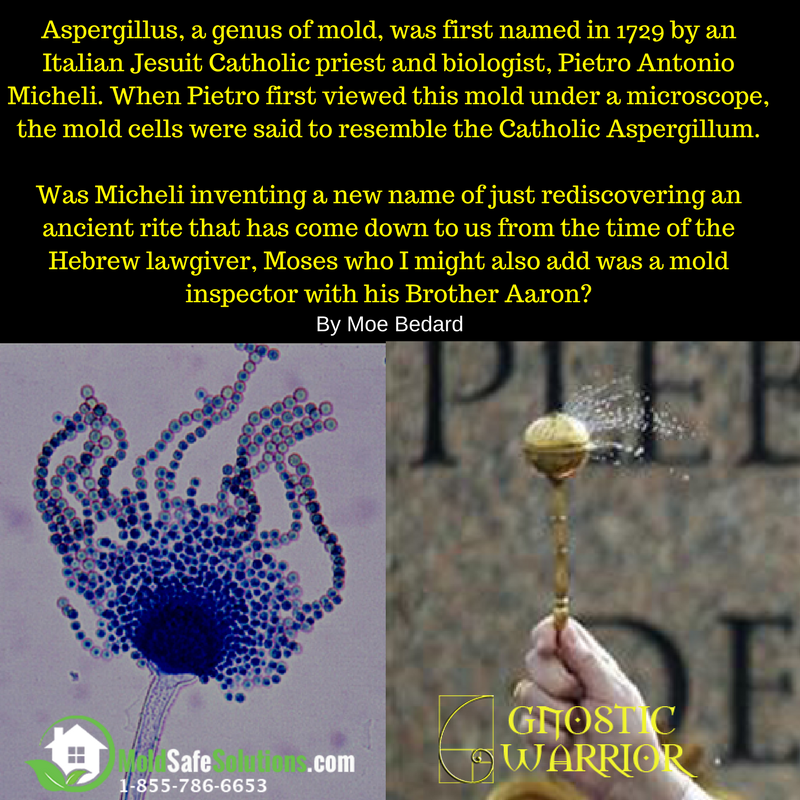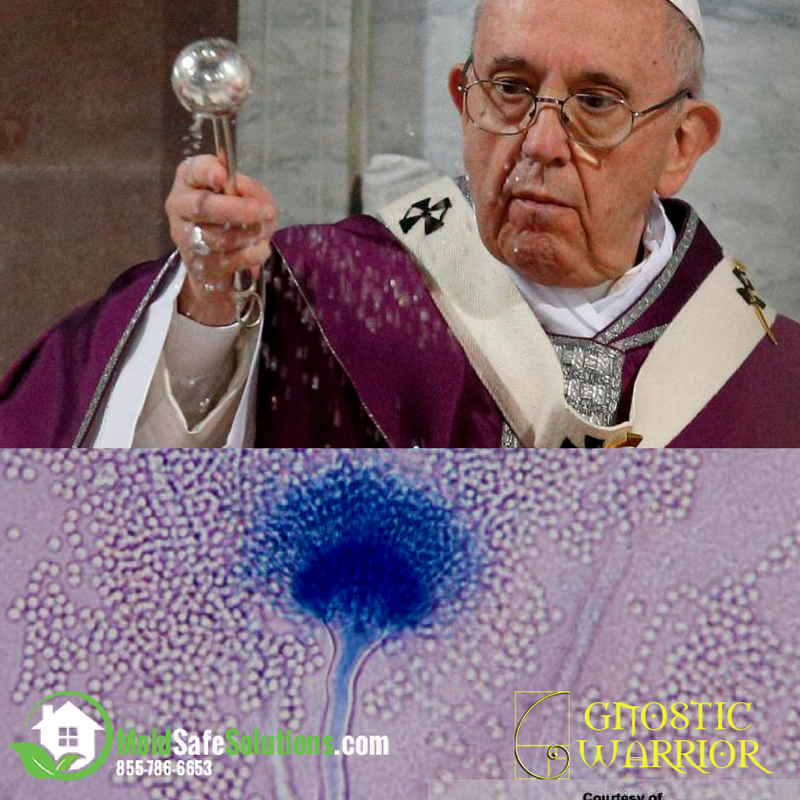“By this Holy water and by your Precious Blood, wash away all my sins O Lord“

As I have mentioned in some of my latest walk and talk videos I have been doing live of Facebook is that the rituals and rites in our world’s most popular Abrahamic religions such as Judaism, Christianity, and Islam deal with protecting against and cleaning yourself of parasitic fungi that they had called “impure or evil spirits.”
An example I would like to point out to you is the relationship between that toxic mold (fungus) that we know of today as Aspergillus and how it is mysteriously connected to the hand held device used by Catholic priests at mass to sprinkle holy water on the faithful called the by the Latin aspergillum name of (asperges).
An interesting note that I would like to point out to you all is the fact that, Aspergillus, a genus of mold, was first named in 1729 by an Italian Jesuit Catholic priest and biologist, Pietro Antonio Micheli. When Pietro first viewed this mold under a microscope, the mold cells were said to resemble the Catholic Aspergillum.
Was Micheli inventing a new name of just rediscovering an ancient rite that has come down to us from the time of the Hebrew lawgiver, Moses who I might also add was a mold inspector with his Brother Aaron?
Maybe the most famous lawgiver and priest of all time Moses and his Bro’ Aaron, the mold experts of Israel knew a thing or two about religion, mold, and the laws to protect ourselves from this toxic (poison) demonic (wise, intelligent) parasitic (vampires, fiends, ghouls) organisms (entities, devils, spirits) who seek to devour (eat, suck our blood) our homes and flesh?
I hope I am giving you some Apocalyptic things to think about….
In any event, the Catholic Aspergillum we get Asperges is the name given to the rite of sprinkling a congregation with holy water. The name comes from the first word in the 9th verse of Psalm 51 in the Latin translation, the Vulgate, which is sung during the Traditional form of the rite, except during Eastertide.
The Asperges was described as follows in the 11th edition of The Encyclopaedia Britannica:
ASPERGES (‘thou wilt sprinkle,’ from the
Latin verb aspergere), the ceremony of the
people with holy water before High Mass in the
Roman Catholic Church … with which the
priest begins the ceremony. The brush used for
sprinkling is an aspergill (aspergillum)…’
(Anonymous, 1910)
The laurel twig used to sprinkle holy water in Roman sacrificial rites was replaced in Christian rites by a special brush known as an aspergillum. In the western Church, this brush developed into a special silver instrument, still used for sprinkling holy water.
An aspergillum is used in Roman Catholic and Anglican ceremonies, including the Rite of Baptism and during the Easter Season. In addition, a priest will use the aspergillum to bless the candles during candlemas services and the palms during Palm Sunday Mass. At a requiem, if a coffin is present, the priest will sprinkle holy water on the coffin. The aspergillum can be used in other manners where sprinkling of holy water is appropriate, as in a house blessing, in which the priest might bless the entry to the home. The name derives from the Latin verb aspergere ‘to sprinkle’.
The form of the aspergillum differs in the Eastern Orthodox Church. In the Greek Orthodox Church the aspergillum (randistirion) is in the form of a standing vessel with a tapering lid. The top of the lid has holes in it from which the agiasmos (holy water) is sprinkled. In the Russian Orthodox Churchthe aspergillum is in the form of a whisk made of cloth or hair. Sometimes, sprigs of basil are used to sprinkle holy water. In some of the Oriental Orthodox Churches, no aspergillum is used, but the priest will pour holy water into the palm of his right hand and throw it on the faithful.
Moe’s Mold Safe Solutions Gnostic Theory
What many people do not understand today is that the Latin Catholic and Greek Orthodox priesthoods were also healers. In ancient times, the role of a priest did not just to assist their flocks and tribes with spiritual teachings and counseling, they were also healers and physicians who used their knowledge (Gnosis) to heal and cure the people.
For example, the Father of Medicine, Hippocrates was a Koan and part of the Kohanim Levites. He is the most famous physician of all time and his descendants were from Moses’ Tribe of Levi. These Levites then became attached to the Catholic Church.
Unfortunately, over time, this priestly profession of the Levites was taken over by the Cainites (merchants) and Pharisees. The Ancient teachings and rites were profaned and Satanism in the form of materialism became the short lived rule of the Anti-Christs.
The aspergillum was used for the health Rites of Aspergee which is the sacred act of sprinkling Holy Water on the Church congregation. This Levitical Holy Water was a special antifungal mixture that the priests had used to treat and cure people during the plague which many authors and experts, including myself, believe was caused by mold. This device is made to look like the mold with a circle or globe (called the
In addition to these facts, this aspergillum device the priests use looks just like an Aspergillus mold spore under a microscope. It can be described as a circle or globe (called the vesicle) that is attached to a handle with spikes around the outside.
This makes sense because they had used the aspergillum to bless a home and the entry way to keep these “impure and evil spirits” that we know today as parasitic molds (fungi) from entering the home. They also used to do it on coffins which were also used as an antifungal to prevent putrefaction of the corpse by these parasites.
Here is an image of the Catholic Pope Francis sprinkling holy water with an aspergillum as a blessing during an Ash Wednesday mass at Saint Peter’s Square at the Vatican.

Pope Francis uses holy water as he celebrates Ash Wednesday Mass at the Basilica of Santa Sabina in Rome March 1. (CNS photo/Paul Haring) See POPE-ASHES March 1, 2017.

An interesting note is that during Lent, Catholics will fast and they do not eat meat. They also receive the cross marked on their foreheads with what we can call “activated charcoal” which is one of my favorite antifungals and detoxing agents.

Now let me please explain to you the purpose of Lent. Lent (Latin: Quadragesima: Fortieth) is a solemn religious observance in the Christian liturgical calendar that begins on Ash Wednesday and ends approximately six weeks later, before Easter Sunday. The purpose of Lent is the preparation of the believer through prayer, doing penance, mortifying the flesh, repentance of sins, almsgiving, and self-denial.
These are all health practices to clean/detox our bodies and to rise above the parasitic influence on our flesh.
Think about this Catholic religious observance. It lasts 6 weeks almost like some type of diet and lifestyle change. They use Ash which I know to be activated charcoal which cleanses the gut (GI tract) of the believer and then they prepare themselves through prayer (positive thinking) and penance (forgiving thyself and others).
Also, they are mortifying the flesh. Mortification of the flesh is an act by which an individual or group seeks to mortify, or put to death, their sinful nature, as a part of the process of sanctification. In Christianity, common forms of mortification that are practiced to this day include fasting, abstinence, as well as pious kneeling. (wikipedia)
To mortify is to subdue (the body or its needs and desires) by self-denial or discipline. In other words, control your appetites and diet so you eat holy and do not serve the parasitic molds (fungi) which seek to rule our flesh and minds.
If we look at the Catholic concept of self-denial, it is really akin to the modern health movement and the various fad diets and complete lifestyle changes etc. They just used different words and rites that were formulated thousands of years ago.

Moe is the founder of GnosticWarrior.com. He is a father, husband, author, martial arts black belt, and an expert in Gnosticism, the occult, and esotericism.






